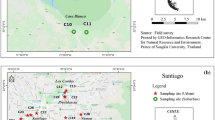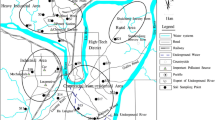Abstract
The sources and the distributions of 23 polycyclic aromatic hydrocarbons (PAHs) in surface (0–5 cm depth) and subsurface (5–10 cm depth) soil in Riyadh, Saudi Arabia, were studied. Isomeric diagnostic ratios of the PAHs (the (anthracene/(anthracene + phenanthrene)), (benz(a)anthracene/(benz(a)anthracene + chrysene)), (fluoranthene/(fluoranthene + pyrene)), (indeno(1,2,3-cd)pyrene/(indeno(1,2,3-cd)pyrene + benzo(g,h,i)perylene)), and (benzo(a)pyrene/benzo(g,h,i)perylene) concentration ratios) were used to determine which anthropogenic sources of PAHs were dominant in different areas. The study area included four areas characterized by different anthropogenic activities; an urban area, an area strongly affected by traffic, a bare area, and an industrial area. The PAHs in all four area types were mainly emitted from factories and other mixed sources. The PAHs concentrations and patterns in some areas reflected the roles of anthropogenic activities in causing environmental pollution, especially the role of infrastructure projects (through emissions during the building work itself and emissions from heavy machinery and transport to and from the site). In contrast, PAHs concentrations and patterns in southern Riyadh showed that the recent improvements in the road network, which has improved traffic flow, have led to decreases in PAHs contamination caused by fuel combustion.




Similar content being viewed by others
References
Adonis M, Martínez V, Riquelme R, Ancic P, González G, Tapia R et al (2003) Susceptibility and exposure biomarkers in people exposed to PAHs from diesel exhaust. Toxicol Lett 144:3–15
Al-Daghri N (2008) Serum polycyclic aromatic hydrocarbons among children with and without asthma: correlation to environmental and dietary factors. Int J Occup Med Environ Health 21:211–217
Al-Daghri N, Alokail M, Abd-Alrahman S, Draz H (2014a) Polycyclic aromatic hydrocarbon distribution in serum of Saudi children using HPLC-FLD: marker elevations in children with asthma. Environ Sci Pollut Res 21:12085–12090
Al-Daghri NM, Alokail MS, Abd-Alrahman SH, Draz HM (2014b) Polycyclic aromatic hydrocarbon distribution in serum of Saudi children using HPLC-FLD: marker elevations in children with asthma. Environ Sci Pollut Res 21:12085–12090
Basahy AY (1987) Suspended particulate and dust fall as pollutants in Riyadh city. Proc Saudi Biol Soc 10:261–269
Boffetta P, Jourenkova N, Gustavsson P (1997) Cancer risk from occupational and environmental exposure to polycyclic aromatic hydrocarbons. Cancer Causes Control 8:444–472
Brandli RC, Bucheli TD, Ammann S, Desaules A, Keller A, Blum F et al (2008) Critical evaluation of PAH source apportionment tools using data from the Swiss soil monitoring network. J Environ Monit 10:1278–1286
Cai Q-Y, Mo C-H, Li Y-H, Zeng Q-Y, Katsoyiannis A, Wu Q-T et al (2007) Occurrence and assessment of polycyclic aromatic hydrocarbons in soils from vegetable fields of the Pearl River Delta, South China. Chemosphere 68:159–168
Chen L, Ran Y, Xing B, Mai B, He J, Wei X et al (2005) Contents and sources of polycyclic aromatic hydrocarbons and organochlorine pesticides in vegetable soils of Guangzhou, China. Chemosphere 60:879–890
Cristale J, Silva FS, Zocolo GJ, Marchi MRR (2012) Influence of sugarcane burning on indoor/outdoor PAH air pollution in Brazil. Environ Pollut 169:210–216
El-Mubarak A, Rushdi A, Al-Mutlaq K, Bazeyad A, Simonich SM, Simoneit BT (2014) Identification and source apportionment of polycyclic aromatic hydrocarbons in ambient air particulate matter of Riyadh, Saudi Arabia. Environ Sci Pollut Res 21:558–567
El-Mubarak A, Rushdi A, Al-Mutlaq K, Bazeyad A, Simonich SM, Simoneit BT (2015) Occurrence of high levels of persistent organic pollutants (pops) in particulate matter of the ambient air of Riyadh, Saudi Arabia. Arab J Sci Eng 40:81–92
El-Saeid M, Al-Turki A, Nadeem MA, Hassanin A, Al-Wabel M (2015a) Photolysis degradation of polyaromatic hydrocarbons (PAHs) on surface sandy soil. Environ Sci Pollut Res 22:9603–9616
El-Saeid MH, Al-Turki AM, Nadeem ME, Hassanin AS, Al-Wabel MI (2015b) Photolysis degradation of polyaromatic hydrocarbons (PAHs) on surface sandy soil. Environ Sci Pollut Res 22:9603–9616
Fadzil MF, Norhayati MT, Wan MK, Wan MZ (2008) Concentration and distribution of polycyclic aromatic hydrocarbons (PAHs) in the town of Kota Bharu, Kelantan. Malays J Anal Sci 12:609–618
Galarneau E (2008) Source specificity and atmospheric processing of airborne PAHs: implications for source apportionment. Atmos Environ 42:8139–8149
Gaspari L, Chang S-S, Santella RM, Garte S, Pedotti P, Taioli E (2003) Polycyclic aromatic hydrocarbon-DNA adducts in human sperm as a marker of DNA damage and infertility. Mutat Res, Genet Toxicol Environ Mutagen 535:155–160
Griffiths HR, Mistry P, Herbert KE, Lunec J (1998) Molecular and cellular effects of ultraviolet light-induced genotoxicity. Crit Rev Clin Lab Sci 35:189–237
Hwang H-M, Wade TL, Sericano JL (2003) Concentrations and source characterization of polycyclic aromatic hydrocarbons in pine needles from Korea, Mexico, and United States. Atmos Environ 37:2259–2267
Hygienists AACoGI (2005) Polycyclic aromatic hydrocarbons (PAHs) biologic exposure indices (BEI). In: American Conference of Governmental Industrial Hygienists. ACIGH, Cincinnati, OH, USA, 2005
Ibuki Y, Warashina T, Noro T, Goto R (2002) Coexposure to benzo[a]pyrene plus ultraviolet A induces 8-oxo-7,8-dihydro-2′-deoxyguanosine formation in human skin fibroblasts: preventive effects of anti-oxidant agents. Environ Toxicol Pharmacol 12:37–42
Ji G, Yan L, Wu S, Liu J, Wang L, Zhang S, Shi L, Gu A (2013) Bulky DNA adducts in human sperm associated with semen parameters and sperm DNA fragmentation in infertile men: a cross-sectional study. Environ Health 12:2–7
Katsoyiannis A, Breivik K (2014) Model-based evaluation of the use of polycyclic aromatic hydrocarbons molecular diagnostic ratios as a source identification tool. Environ Pollut 184:488–494
Katsoyiannis A, Terzi E, Cai Q-Y (2007) On the use of PAH molecular diagnostic ratios in sewage sludge for the understanding of the PAH sources. Is this use appropriate? Chemosphere 69:1337–1339
Khalili NR, Scheff PA, Holsen TM (1995) PAH source fingerprints for coke ovens, diesel and gasoline engines, highway tunnels, and wood combustion emissions. Atmos Environ 29:533–542
Li B, Feng C, Li X, Chen Y, Niu J, Shen Z (2012) Spatial distribution and source apportionment of PAHs in surficial sediments of the Yangtze Estuary, China. Mar Pollut Bull 64:636–643
Li P, Xue R, Wang Y, Zhang R, Zhang G (2015) Influence of anthropogenic activities on PAHs in sediments in a significant gulf of low-latitude developing regions, the Beibu Gulf, South China Sea: distribution, sources, inventory and probability risk. Mar Pollut Bull 90:218–226
Manoli E, Kouras A, Samara C (2004) Profile analysis of ambient and source emitted particle-bound polycyclic aromatic hydrocarbons from three sites in northern Greece. Chemosphere 56:867–878
Mason BJ Preparation of soil sampling protocols: Sampling techniques and strategies. Other Information: See also PB–83-206979, 1992, pp. Medium: X; Size: Pages: (166 p)
Menoret P. Joyriding in Riyadh Oil, Urbanism, and Road Revolt. Part of Cambridge Middle East Studies, 2014
Modaihsh AS (1997) Characteristics and composition of the falling dust sediments on Riyadh city, Saudi Arabia. J Arid Environ 36:211–223
Moya J, Phillips L (2014) A review of soil and dust ingestion studies for children. J Expos Sci Environ Epidemiol 24:545–554
Nikolaou K, Masclet P, Mouvier G (1984) Sources and chemical reactivity of polynuclear aromatic hydrocarbons in the atmosphere—A critical review. Sci Total Environ 32:103–132
Page AL. Methods of soil analysis. Part 2. Chemical and microbiological properties. USA: American Society of Agronomy, Soil Science Society of America, 1982
Pálková L, Vondráček J, Trilecová L, Ciganek M, Pěnčíková K, Neča J et al (2015) The aryl hydrocarbon receptor-mediated and genotoxic effects of fractionated extract of standard reference diesel exhaust particle material in pulmonary, liver and prostate cells. Toxicol Vitro 29:438–448
Ratola N, Alves A, Lacorte S, Barceló D (2012) Distribution and sources of PAHs using three pine species along the Ebro River. Environ Monit Assess 184:985–999
Ravindra K, Sokhi R, Van Grieken R (2008a) Atmospheric polycyclic aromatic hydrocarbons: source attribution, emission factors and regulation. Atmos Environ 42:2895–2921
Ravindra K, Wauters E, Van Grieken R (2008b) Variation in particulate PAHs levels and their relation with the transboundary movement of the air masses. Sci Total Environ 396:100–110
Registry AAfTSaD. Case Studies in Environmental Medicine Toxicity of Polycyclic Aromatic Hydrocarbons (PAHs), 2012
Registry AAfTSaD. Toxicological profile for polycyclic aromatic hydrocarbons (PAHs) (update). In: Services DoHaH, editor, Atlanta, GA: US 1995
Riyadh HHCftDoA (2015)
Rushdi A, Al-Mutlaq K, Simoneit BT (2005) Sources of organic compounds in fine soil and sand particles during winter in the metropolitan area of Riyadh, Saudi Arabia. Arch Environ Contam Toxicol 49:457–470
Skupinska K, Misiewicz I, Kasprzycka-Guttman T (2004) Polycyclic aromatic hydrocarbons: physicochemical properties, environmental appearance and impact on living organisms. Acta Pol Pharm Drug Res 61:233–240
SSSA. Methods of Soil Analysis. Vol Part I. Madison, WI: American Society of Agronomy and Soil Science Society of America, 1986
Surfer GS (2012) Golden Software. Surfer, San Francisco
Tay C, Biney C (2013) Levels and sources of polycyclic aromatic hydrocarbons (PAHs) in selected irrigated urban agricultural soils in Accra, Ghana. Environ Earth Sci 68:1773–1782
Thorne CWAB (1997) Applied statistical methods. Prentice Hall, Upper Saddle River
Tobiszewski M, Namieśnik J (2012) PAH diagnostic ratios for the identification of pollution emission sources. Environ Pollut 162:110–119
Weaver RWA, Bottomley S, Bezdicek P, Smith D, Tabatabai S, Wollum A, Mickeson A, Bigham SH J.M.; eds.. Chemical and Microbiological Properties. Vol Part 2: American Society of Agronomy and Soil Science Society of America, 1982
Xiao Y, Tong F, Kuang Y, Chen B (2014) Distribution and source apportionment of polycyclic aromatic hydrocarbons (PAHs) in forest soils from urban to rural areas in the Pearl River Delta of Southern China. Int J Environ Res Public Health 11:2642
Yunker MB, Macdonald RW, Vingarzan R, Mitchell RH, Goyette D, Sylvestre S (2002) PAHs in the Fraser River basin: a critical appraisal of PAH ratios as indicators of PAH source and composition. Org Geochem 33:489–515
Zakaria MP, Takada H, Tsutsumi S, Ohno K, Yamada J, Kouno E et al (2002) Distribution of polycyclic aromatic hydrocarbons (PAHs) in rivers and estuaries in Malaysia: a widespread input of Petrogenic PAHs. Environ Sci Technol 36:1907–1918
Zhang Y, Tao S (2009) Global atmospheric emission inventory of polycyclic aromatic hydrocarbons (PAHs) for 2004. Atmos Environ 43:812–819
Zheng B, Hwang H-M, Yu H, Ekunwe S (2004) DNA damage produced in HaCaT cells by combined fluoranthene exposure and ultraviolet A irradiation. Environ Mol Mutagen 44:151–155
Acknowledgements
This project was funded by the National Plan for Sciences, Technologies, and Innovation (MAARIFAH) King Abdul-Aziz City for Sciences and Technology, KSA. Project Number (11-ENV-2660-02).
Author information
Authors and Affiliations
Corresponding author
Rights and permissions
About this article
Cite this article
EL-Saeid, M.H., Sapp, J.B., Nadeem, M.E.A. et al. Distribution, sources and factors influencing the dissipation of polycyclic Aromatic hydrocarbons in urban soils. Environ Earth Sci 76, 730 (2017). https://doi.org/10.1007/s12665-017-7063-1
Received:
Accepted:
Published:
DOI: https://doi.org/10.1007/s12665-017-7063-1




